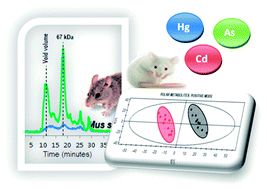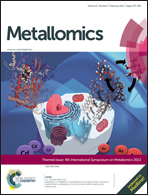Application of metallomic and metabolomic approaches in exposure experiments on laboratory mice for environmental metal toxicity assessment
Abstract
Metals have a central role in biological systems, regulating numerous cellular processes, and in other cases having toxic or deleterious effects on the metabolism. Hence, the study of metal-induced changes in cellular metabolic pathways is crucial to understanding the biological response associated with environmental issues. In this context, the finding of biomarkers has great interest, representing -omics techniques, such as metallomics and metabolomics, powerful tools for this purpose. The present work evaluates the exposure of mice Mus musculus to toxic metals (As, Cd and Hg), considering the changes induced in both the metallome and metabolome as a consequence of the high genetic homology between Mus musculus/Mus spretus mice, which allows the use of the database from M. musculus to identify the proteins and metabolites expressed by M. spretus. For this purpose a metallomic approach based on size exclusion chromatography (SEC) in combination with other complementary orthogonal separation techniques and heteroelement monitoring by ICP-ORS-qMS was performed, followed by identification of metallobiomolecules by organic mass spectrometry. In addition, simultaneous speciation of selenoproteins and selenometabolites in mouse plasma was accomplished by tandem (double) SEC-(dual) affinity chromatography (AF)-HPLC and online isotope dilution analysis (IDA)-ICP-ORS-qMS. Finally, the simultaneous changes in metabolic expression in mice caused by metal exposure (metabolome) were considered, using direct infusion mass spectrometry (DI-ESI-QqQ-TOF-MS) of extracts from mice plasma. Subsequently altered metabolites were identified using MS/MS experiments. The results obtained under controlled conditions were extrapolated to homologous free-living mice captured in Doñana National Park (DNP) and surroundings (southwest Spain) affected by As, Cd and Hg pollution. In summary, such studies are needed to understand the effect of heavy metal exposure and cope with heavy metal toxicity.

- This article is part of the themed collection: Fourth International Symposium on Metallomics, Oviedo, Spain

 Please wait while we load your content...
Please wait while we load your content...